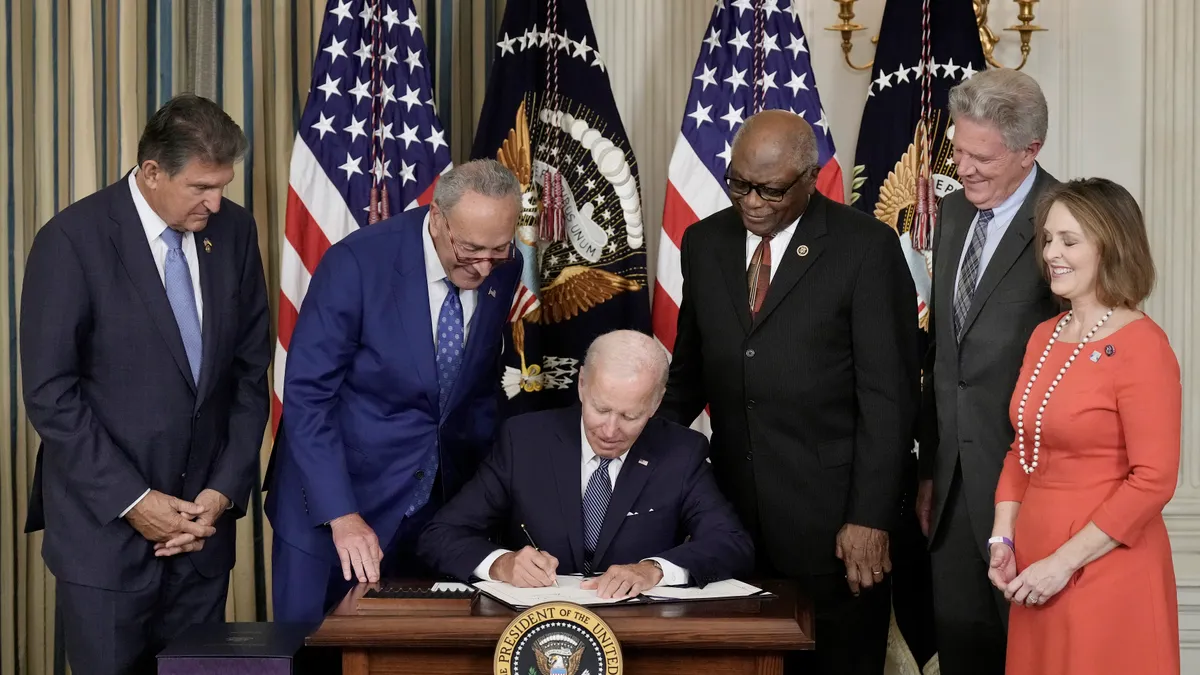The Inflation Reduction Act turns two in August, and the potential impact of the legislation is increasingly coming into view as federal guidance is issued on the law’s provisions and its tax incentives increasingly spur private investment.
So far this year, 41 major clean energy projects and $12.6 billion in private investment have been announced, according to business group E2, and 2024 has seen the IRS issue final guidance for the IRA’s prevailing wage and apprenticeship requirements as well as its tax credit transferability mechanism.
The IRS also proposed guidance this year on the IRA’s technology-neutral 48E and 45Y credits, issued clarifying guidance on what qualifies as an energy community, and issued guidance on the domestic content bonus credit — extending its applicability for hydropower and solar.
However, the clean energy industry is still waiting on final guidance for the 45V hydrogen tax credit, said Lesley Hunter, senior vice president of policy and engagement at the American Council on Renewable Energy.
“Significant uncertainty was created by the proposal late last year, and Treasury has received significant feedback about the workability of the limitations for qualifying projects,” Hunter said. “So that's final guidance we should be seeing later this year.”
On the other hand, she said, the guidance that has been released so far this year “has been effective in alleviating” some of the clean energy industry’s concerns.
Market shakeups
Hunter said that the finalized tax credit transferability guidance released in April has helped drive the new and thriving market of clean energy tax credit transactions. A January report from Crux Climate estimated that $7 billion to $9 billion in transactions occurred last year, and the company said in April that transactions this year may “significantly exceed” that number.
Hunter added that she anticipates the IRA to be a “long-term stimulus” for the clean energy sector, especially when the 48E and 45Y technology-neutral credits replace existing production and investment tax credits at the end of this year. The new credits are set to phase out either in 2032, or when U.S. carbon emissions reach 50% of 2022 levels.
As the IRA drives a clean energy manufacturing and generation boom, some sectors of the industry are disagreeing about how the U.S. should approach associated trade policy. The solar industry is currently split over a petition filed in April by an alliance of seven U.S. solar manufacturers, asking the U.S. to impose antidumping and countervailing duties on crystalline silicon solar cells imported from Cambodia, Malaysia, Thailand and Vietnam.
One of the manufacturers is First Solar, whose CEO Mark Widmar testified before the the Senate Finance Committee in March, “There is great risk that the largest beneficiary of the IRA’s solar energy tax credits may be China.”
Interest rates have remained at a 23-year high this year, thwarting industry’s hope for cuts. David Carter, a senior analyst at consulting firm RSM US LLP, said he’s seen “the higher cost of capital and tighter access to capital …. really driving companies back to fundamentals. They're focusing on identifying ways to increase revenue, to improve their margin and maximize the rate of return on investments.”
Carter said that he’s seen clean energy developers starting to adapt, too, in response to transmission headwinds they face when bringing projects online.
“There's been an increase in new generation being connected directly to industrial facilities, quote unquote, behind the meter,” he said. “And that's a way to allow them to get projects online faster, and make the economics a little bit more attractive.”
RSM’s economists are forecasting a 25 basis point cut for interest rates in September and another in December, with “some more following next year,” Carter said. “Overall, we're seeing that the strength of the economy is solid.”
New funding and grants
“The story of the first year [of the IRA] was very much folks moving relatively quickly to take advantage of some of the new or reauthorized, expanded tax credits — and the ability of the private sector and private capital to move quickly,” said Harry Godfrey, who leads Advanced Energy United’s federal investment and manufacturing working group.
Godfrey said that he thinks the biggest IRA story so far in 2024 “is the dollars flowing out the door from the feds to the states, to not-for-profit entities, to municipalities.”
Some of that IRA funding is beginning to flow freely, he said, while other programs will take longer to implement — such as the EPA’s $27 billion Greenhouse Gas Reduction Fund.
The disbursement of $5 billion in Climate Pollution Reduction Grants to the states also remains underway, but Godfrey said he found it “encouraging” to see that 47 of 50 states so far have used associated planning dollars to produce climate action plans.
“They vary in terms of the granularity, the quality, the specificity, but states broadly produced plans where they were talking about sector-by-sector decarbonization, and how they can go about doing that,” he said.
Regardless of which presidential candidate wins in November, Godfrey said he thinks 2025 will see the states “have a really central role” in the IRA’s implementation, as well as its “ultimate success, or failure.”























